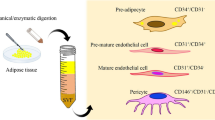Abstract
By using Ca2+ imaging and Fluo-4 dye, we examined the capability of certain agonists of G-protein coupled receptors to stimulate Ca2+ signaling in cultured mesenchymal stromal cells (MSC) derived from the human adipose tissue. In particular, a small subpopulation (∼5%) MSC was found to respond to noradrenaline with Ca2+ transients. The all-or-nothing fashion was characteristic of adrenergic Ca2+ signaling in MSC, that is, while at low concentrations noradrenaline stimulated undetectable Ca2+ transients, virtually maximal responses were elicited by this agonist at any concentration above the threshold of 100–200 nM. In some experiments, MSC were loaded with the photosensitive Ca2+ chelator NP-EGTA to produce local or global jumps in cytosolic Ca2+ concentration by virtue of Ca2+ uncaging. Global uncaging eliciting a high enough Ca2+ jump triggered a Ca2+ transient in the MSC cytoplasm, which was similar to a noradrenaline response kinetically and by magnitude. When Ca2+ uncaging was produced locally, it initiated a Ca2+ signal that traveled along a cell with a speed that exceeded an expected one by two orders of magnitude, should Ca2+ signal transfer be mediated merely by passive Ca2+ diffusion in the presence of Ca2+ buffer. These findings implicated Ca2+-induced Ca2+ release (CICR) as a mechanism amplifying local Ca2+ signals in MSC. Of Ca2+ targets involved in CICR, the ryanodine receptor and IP3 receptor are only known. The inhibitory analysis revealed IP3 receptors to be principally responsible for CICR in MSC, whereas a contribution of ryanodine receptors was negligible. Altogether, our results suggest that an initial noradrenaline-dependent rise in cytosolic Ca2+ stimulates, should it reach the threshold level, IP3 receptors, thereby triggering an avalanche-like Ca2+ release from Ca2+ stores and underlying the all-or-nothing dependence of cellular responses on the agonist concentration.
Similar content being viewed by others
References
Kalinina N.I., Sysoeva V.Yu., Rubina K.A., Parfenova Ye.V., Tkachuk V.A. 2011. Mesenchymal stem cells in tissue growth and repair. Acta Natura. 3(4), 30–37.
Baer P.C., Geiger H. 2012. Adipose-derived mesenchymal stromal/stem cells: Tissue localization, characterization, and heterogeneity. Stem Cells Intern. 812693.
Ye B. 2010. Ca2+ oscillations and its transporters in mesenchymal stem cells. Physiol. Res. 59, 323–329.
Horwitz E.M., Le Blanc K., Dominici M., Mueller I., Slaper-Cortenbach I., Marini F.C., Deans R.J., Krause D.S, Keating A. 2005. Clarification of the nomenclature for MSC: The international society for cellular therapy position statement. Cytotherapy. 7, 393–395.
Khokhlov A.A., Romanov R.A., Zubov B.V., Pashinin A.D., Kolesnikov S.S. 2007. An LED-based illuminator for microphotometric studies of cells. Pribory i tekhnika eksperimenta (Rus.). 50(3), 128–131.
Baryshnikov S.G., Rogachevskaja O.A., Kolesnikov S.S. 2003. Calcium signaling mediated by P2Y receptors in mouse taste cells. J. Neurophysiol. 90, 3283–3294.
Petrel C., Kessler A., Dauban P., Dodd R.H., Rognan D., Ruat M. 2004. Positive and negative allosteric modulators of the Ca2+-sensing receptor interact within over-lapping but not identical binding sites in the transmembrane domain. J. Biol. Chem. 279, 18990–18997.
Perkins W.J., Kost S., Danielson M. 2009. Prolonged NO treatment decreases α-adrenoreceptor agonist responsiveness in porcine pulmonary artery due to persistent soluble guanylyl cyclase activation. Am. J. Physiol. Lung Cell Mol. Physiol. 296, L666–L673.
Ellis-Davies G.C. 2007. Caged compounds: Photore-lease technology for control of cellular chemistry and physiology. Nature Methods. 4, 619–628.
Berridge, M.J., Bootman, M.D, Roderick, H.L. 2003. Calcium signaling: Dynamics, homeostasis and remodeling. Nat. Rev. Mol. Cell Biol. 4, 517–529.
Clapham D.E. 2007. Calcium signaling. Cell. 131, 1047–1058.
Wagner J., Keizer J. 1994. Effects of rapid buffers on Ca2+ diffusion and Ca2+ oscillations. Biophys. J. 67, 447–456.
Jafri M.S., Keizer J. 1995. On the roles of Ca2+ diffusion, Ca2+ buffers, and the endoplasmic reticulum in IP3-induced Ca2+ waves. Biophys. J. 69, 2139–2153.
Neher E. 1995. The use of Fura-2 for estimating Ca buffers and Ca fluxes. Neuropharm. 34, 1423–1442.
Allbritton, N. L., Meyer T., L. Stryer L. 1992. Range of messenger action of calcium ion and inositol 1,4,5-trisphosphate. Science. 258, 1812–1815.
Zhou, Z., Neher E. 1993. Mobile and immobile calcium buffers in bovine adrenal chromaffin cells. J. Physiol. 469, 245–273.
Xu S.-Z., Zeng F., Boulay G., Grimm C., Harteneck C., Beech D.J. 2005. Block of TRPC5 channels by 2-aminoethoxydiphenyl borate: A differential, extracellular and voltage-dependent effect. Br. J. Pharmacol. 145, 405–414.
Mustafa T., Walsh J., Grimaldi M., Eiden L.E. 2010. PAC1hop receptor activation facilitates catecholamine secretion selectively through 2-APB-sensitive Ca2+ channels in PC12 cells. Cell Signal. 22, 1420–1426.
Harteneck C., Gollasch M. 2011. Pharmacological modulation of diacylglycerol-sensitive TRPC3/6/7 channels. Curr. Pharm. Biotechnol. 12, 35–41.
Kiselyov K., Shin D.M., Muallem S. 2003. Signaling specificity in GPCR-dependent Ca2+ signaling. Cell. Signal. 15, 243–253.
White C., Yang J., Monteiro M.J., Foskett J.K. 2006. CIB1, a ubiquitously expressed Ca2+-binding protein ligand of the InsP3 receptor Ca2+ release channel. J. Biol. Chem. 281, 20825–20833.
Author information
Authors and Affiliations
Corresponding author
Additional information
Original Russian Text © P.D. Kotova, P.A. Turin-Kuzmin, O.A. Rogachevskaja, J.I. Fadeeva, V.Yu. Sysoeva, V.A. Tkachuk, S. S. Kolesnikov, 2013, published in Biologicheskie Membrany, 2013, Vol. 30, No. 5–6, pp. 422–429.
Rights and permissions
About this article
Cite this article
Kotova, P.D., Turin-Kuzmin, P.A., Rogachevskaja, O.A. et al. Calcium-induced calcium release mediates all-or-nothing responses of mesenchymal stromal cells to noradrenaline. Biochem. Moscow Suppl. Ser. A 8, 82–88 (2014). https://doi.org/10.1134/S1990747813050085
Received:
Published:
Issue Date:
DOI: https://doi.org/10.1134/S1990747813050085




